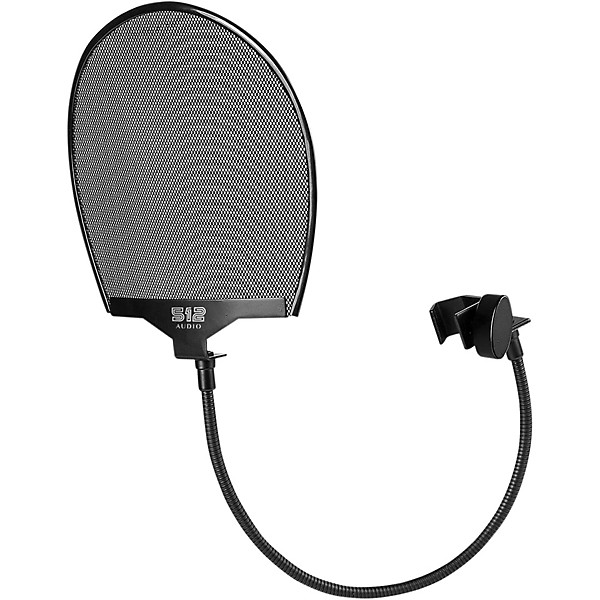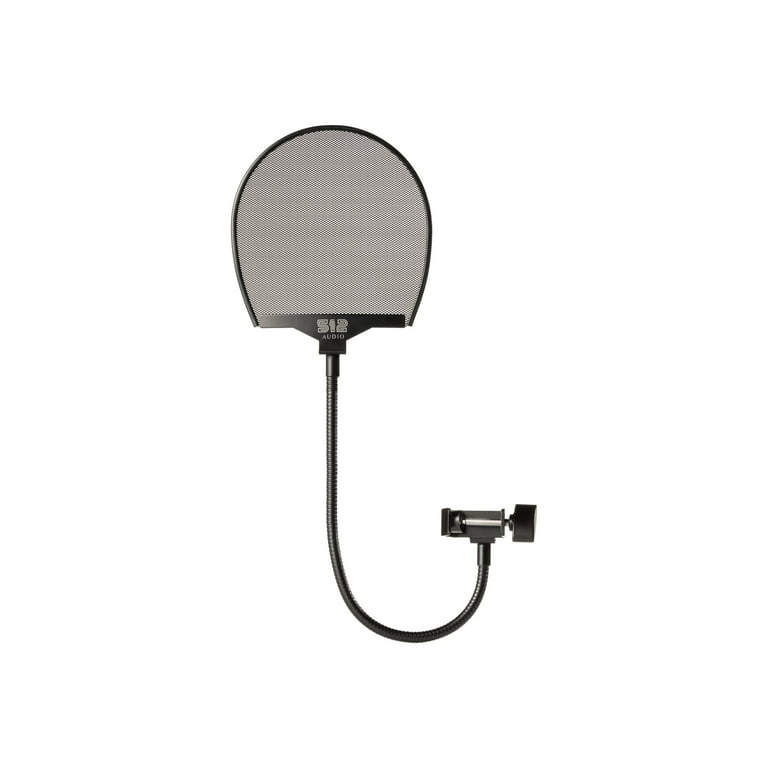Pop filters are essential to reduce popping sounds in recordings for clearer audio quality. They prevent plosives from distorting sound.
Pop filters are a must-have tool for anyone looking to improve the quality of their audio recordings. By effectively reducing unwanted popping sounds caused by the forceful expulsion of air when pronouncing certain consonants, pop filters enhance the clarity and overall professionalism of the audio.
Whether you are a podcaster, musician, voice-over artist, or content creator, using pop filters can significantly elevate the standard of your recordings. We will explore the importance of pop filters in various scenarios and how they contribute to producing top-notch audio content.

Credit: www.amazon.com
The Importance Of Pop Filters
When recording audio, pop filters are essential tools that can make a significant difference in the overall quality of your sound. Pop filters help eliminate unwanted plosive sounds, improve vocal clarity, and enhance the overall listening experience.
Preventing Plosive Sounds
Plosive sounds, such as the “p” and “b” sounds, can cause distortion and affect the clarity of your recordings. A pop filter acts as a barrier, dispersing the air and preventing these sounds from reaching the microphone directly.
Improving Vocal Clarity
Pop filters help in maintaining a consistent distance between the microphone and the vocalist, reducing any sudden spikes in volume. This leads to improved vocal clarity and a more balanced sound output.
Types Of Pop Filters
There are two main types of pop filters commonly used in audio recording: Nylon Mesh Filters and Foam Filters.
Nylon Mesh Filters
Nylon mesh filters, also known as fabric pop filters, are made of a fine nylon mesh stretched over a circular frame. They effectively diffuse strong bursts of air from vocal plosives.
Foam Filters
Foam filters, on the other hand, consist of a thick layer of foam encased in a frame. They are excellent at reducing plosives and high-frequency sounds without overly affecting the overall sound quality.
How To Choose The Right Pop Filter
When it comes to choosing the right pop filter, there are a few key factors to consider to ensure that you make the best choice for your recording setup. From the type of microphone you use to your budget and the durability of the pop filter, each consideration plays a significant role in your decision-making process.
Consideration Of Microphone Type
The type of microphone you use can influence the pop filter you choose. For condenser microphones, a double-layered nylon pop filter can effectively reduce plosive sounds while maintaining the natural tone of the vocals. On the other hand, dynamic microphones may benefit from a metal mesh pop filter that offers durable protection against strong airflow and pops.
Factor In Budget And Durability
Your budget plays a crucial role in determining the pop filter that is right for you. While there are affordable options available, investing in a durable pop filter can ensure longevity and consistent performance, ultimately saving you money in the long run. By factoring in the durability of the pop filter, you can avoid frequent replacements and maintain high-quality recordings.

Credit: www.guitarcenter.com
Using Pop Filters Effectively
A pop filter is an essential tool for any recording setup, whether you are a professional musician or a podcast enthusiast. These handy accessories can significantly improve the quality of your audio recordings by reducing plosive sounds caused by hard consonants like “p” and “b”. However, to maximize the benefits of a pop filter, it is crucial to use it effectively. In this article, we will explore proper placement techniques and share tips for maintenance.
Proper Placement Techniques
Placing your pop filter correctly is key to achieve the best results. The primary purpose of a pop filter is to act as a physical barrier between your microphone and your mouth, minimizing the impact of plosives on the microphone’s diaphragm. Follow these proper placement techniques to obtain optimal performance:
- Position the pop filter approximately two to six inches away from the microphone, ensuring it covers the entire diameter of the microphone.
- Angle the pop filter slightly downward, pointing it towards the center of the microphone.
- Make sure the pop filter is secure and tightly fastened to a stand or boom arm.
By adhering to these placement techniques, you can effectively reduce plosives and prevent unwanted distortion, resulting in crystal-clear recordings.
Tips For Maintenance
To ensure that your pop filter continues to serve you well, it is essential to maintain and clean it regularly. Here are some simple tips for proper pop filter maintenance:
- Wipe the pop filter with a soft, lint-free cloth after each use to remove any saliva, dust, or debris.
- Avoid using harsh cleaners or solvents that may damage the filter material.
- If your pop filter has a removable screen or filter, consider washing it with mild soap and water, allowing it to air dry.
- Inspect the pop filter regularly for any signs of wear or tear, such as loose threads or holes. If you notice any damage, it may be time to replace the filter.
By following these maintenance tips, you can extend the lifespan of your pop filter and ensure it continues to provide optimal performance in your recordings.
Pop Filters In Different Settings
Pop filters are essential in various settings to minimize popping and unwanted noises in recordings. These filters effectively enhance vocal quality for podcasting, singing, or voiceover work. Whether in a studio or home environment, pop filters ensure clear and professional audio output.
Pop filters are essential tools for achieving clean and professional audio recordings. While their primary purpose is to minimize the harsh plosive sounds caused by the pronunciation of certain letters, such as “p” and “b”, pop filters have a significant impact on the overall recording quality. Moreover, pop filters are invaluable in various audio settings, such as recording studios and live performances. By understanding their role in different environments, you can optimize your audio setup for the best results.
Recording Studios
Recording studios are the birthplace of many great songs and podcasts. These controlled environments are specifically designed to capture sound with utmost clarity and precision. When it comes to recording vocals, pop filters play a vital role in ensuring clean and distortion-free recordings. By strategically positioning a pop filter between the microphone and the performer, unwanted plosive bursts are effectively diffused, resulting in a more natural and pleasing sound.
In recording studios, every detail is meticulously addressed to produce professional-grade audio. With a pop filter in place, audio engineers can focus on capturing the nuances of the performance, rather than spending precious time on post-production editing to remove unwanted pops and low-frequency rumble. Moreover, the use of pop filters in recording studios helps maintain consistency in vocal recordings, as the integration of these filters becomes part of the standardized equipment setup.
Live Performances
Live performances, such as concerts and speaking engagements, pose unique challenges when it comes to audio quality. While stage performers rely on powerful sound systems to project their voices to a large audience, the presence of plosive bursts can hinder the clarity and intelligibility of their vocals. This is where pop filters come to the rescue.
In live performances, pop filters provide a practical solution to the challenges posed by plosive bursts. By incorporating pop filters into live sound setups, performers can deliver their messages with crisp and clear vocals, free from distracting pops and puffs of air. This is particularly important when addressing large crowds, where every word matters and capturing the attention of listeners is crucial. Pop filters ensure that the impact of a live performance is enhanced, allowing the audience to fully engage with the content.
Furthermore, the use of pop filters in live performances helps prevent feedback issues, often caused by the exaggerated bass response resulting from plosive sounds. By eliminating these unwanted bursts of low-frequency energy, pop filters contribute to a more controlled sound, ultimately enhancing the overall listening experience for the audience.

Credit: www.walmart.com
Frequently Asked Questions For Why You Need Pop Filters
Why Are Pop Filters Important For Recording Vocals?
Pop filters are essential for recording vocals as they help reduce plosive sounds caused by certain consonant sounds like ‘p’ and ‘b’. They prevent these explosive noises from distorting the microphone and result in a cleaner and more professional sound quality.
How Do Pop Filters Work?
Pop filters work by creating a physical barrier between the vocalist and the microphone. They are made of a fine mesh or nylon material that acts as a filter for plosive sounds. As the vocalist speaks or sings, the bursts of air are diffused by the pop filter, reducing the impact on the microphone and minimizing unwanted noise.
Are Pop Filters Necessary For Podcasting?
Yes, pop filters are highly recommended for podcasting. Podcasters speak closely to the microphone, increasing the likelihood of plosive sounds. Pop filters help in preventing these sounds from being recorded, resulting in clearer audio quality and a more pleasant listening experience for your audience.
Can Pop Filters Be Used With Usb Microphones?
Yes, pop filters can be used with USB microphones. They are designed to fit easily onto the microphone stand or mount, and can be adjusted according to your needs. Using a pop filter with a USB microphone helps eliminate plosive sounds and ensures better audio quality for your recordings.
Conclusion
To sum up, pop filters are essential tools for enhancing the quality of your audio recordings. By reducing unwanted noises and distortions, pop filters allow for clearer and more professional sound output. With the potential to elevate the overall production value of your content, investing in pop filters is a prudent choice for any aspiring or seasoned content creator.